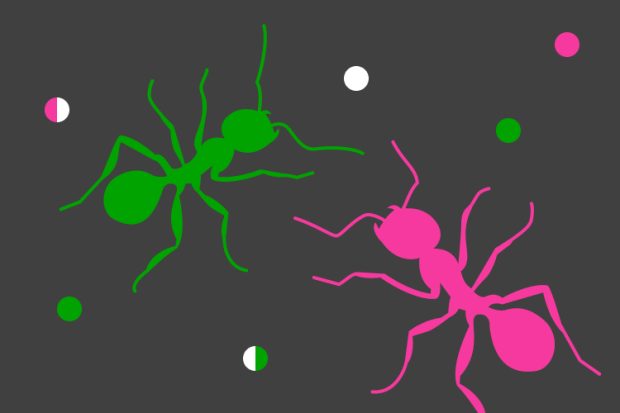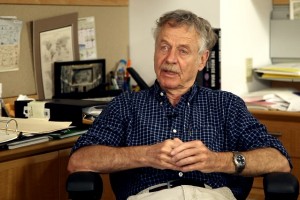The Role of Mitochondria in Aging and Disease
Biologist David Sinclair on alphaproteobacteria, reactive oxygen species, and why the nucleus and the mitochon...
The scale of human cooperation is really quite puzzling from a biological point of view. When we look elsewhere in the natural world, when we look at ants, amoebas, meerkats, baboons, or chimpanzees, what we find is that cooperation tends to be restricted to relatively small groups. Those groups are formed of genetic relatives, and in some sense, they help each other because they’re genetic relatives because they share genes. That shared genetic interest in the future is what leads natural selection to favour helping behaviour within these groups. We see this pattern right across the natural world until we get to humans.
Humans don’t just cooperate in small groups formed of close relatives and then behave aggressively with hostility to individuals in other groups. Instead, we find very, very large-scale societies. This isn’t even a recent phenomenon: even in human prehistory, before nation-states, as we know them, before governments, before societies of millions of people, there were still tribal groups. Tribal groups have maybe 500-1000 individuals. They weren’t composed of close genetic relatives; this was about cooperation on a very large scale, involving individuals who would have barely known each other, who would have been essentially strangers to each other, nevertheless acting cooperatively, helping each other, at the very least interacting non-aggressively when they met and recognised each other as members of the same tribe.
This really bucks the trend across the rest of the natural world and leaves evolutionary theorists scratching their heads for an explanation. What is it that explains cooperation in large groups of genetic non-relatives? It’s not kin selection as we know it in the ordinary sense. So what is it?
My strong suspicion (a suspicion that I share with a lot of evolutionary anthropologists working in this area) is that the key to understanding human cooperation is cultural evolution: not genetic evolution, but cultural evolution. Cultural evolution is like genetic evolution, and you have processes a bit like natural selection, processes that are a bit Darwinian at work, favouring some variants over others. But the units here are not genes; it’s not genes that are being selected: it’s beliefs, values, skills, and representations in people’s heads, what are often called cultural variants. They don’t have to be memes: the concept of a meme from Richard Dawkins is a famous way of understanding cultural evolution on which the units of cultural transmission and learning are taken to be very much like genes; they’re taken to be little particles that are transmitted by themselves with high fidelity. It doesn’t have to work exactly like that: we can be talking here about beliefs, values, and skills that kind of blend when you learn from many, many individuals. What you inherit is a kind of blend of their beliefs, values and skills, not just a meme.
But the thought is that even if the cultural inheritance is a bit of a mess in that sense, it’s kind of blending inheritance rather than all about memes that can still be interesting analogies to be drawn between processes of cultural change and processes of genetic evolution and that these processes of cultural evolution are what lead to a kind of altruism in humans that we just don’t see in chimpanzees, our closest living relatives. Chimpanzees live in small groups, and in general, when they encounter individuals from other groups, those interactions are very, very hostile. They’ll quite happily, given the chance, kill a chimpanzee from a rival group who strays into their territory. This is why chimpanzees don’t really have tribes to speak of; they don’t cooperate with non-relatives in the right kind of way.
So how do we go about building a theory of cultural evolution that will help us explain human altruism? What should the core principles of that theory be?
I think a very good place to look is actually the theory of kin selection or inclusive fitness, which is really, I think, our best current theory of how altruism evolves by genetic evolution. I think we should be looking at that theory and try to think of ways in which we can take the core principles of that theory and apply them to the cultural case.
So if you think of ants, the idea is that the workers help the queen because r is positive, the workers are related to the queen, and rB outweighs C, the cost the ants incur by helping the queen is outweighed by the benefit times r that they confer on the queen. And I think we should be looking for ways to transpose that insight across to the case of human cultural evolution. That means we have to think about the key terms quite differently.
It means that instead of thinking about a coefficient of genetic relatedness we need to be thinking about a coefficient of cultural relatedness where cultural relatedness is not about the genetic similarity between you and the person you’re helping, but rather about the cultural similarity, your tendency to share beliefs, values, skills with that potential beneficiary.
The basic idea is the same: you have an incentive to help those individuals who share the transmissible basis of the behaviour you’re performing. All we’re doing is saying that instead of the behaviour being based on genes, the behaviour is based on beliefs, values, skills and so on.
That’s a basic idea. It leaves a lot of questions unanswered; it leaves a lot of complications about how we flesh out the details about how to apply Hamilton’s insights from the genetic case in the cultural case. I don’t have time to go into all of those details here.
I’ll just say that I think this is an area in which anthropologists can actually learn quite a lot from microbiologists, and people studying humans can learn quite a lot from people studying bacteria.
The reason for this is that despite all of the obvious differences between humans and bacteria (we don’t split in half every 20 minutes; they don’t have institutions, religions, states and so on), there’s a very important similarity, and that similarity is a horizontal transmission. What I mean by that is that bacteria trade genes with each other: when they meet in natural populations, sometimes they touch, they conjugate, and little packets of DNA called plasmids can move from one bacterium to another. So genetic material starts off in one bacterium and ends up in another, replicates through cell-to-cell contact, and so these bacteria end up sharing genes with each other that they didn’t share before. So we have here a conception of how it can be that two organisms can come to resemble each other genetically not because they’re actually close relatives but because they’ve engaged in a process, a contact process that led to horizontal transmission of genes from one to the other.

This resembles, in interesting ways, the process of social learning where humans don’t simply have the beliefs, values, and skills they got from their parents but actually meet with each other in social situations and learn from each other socially. These processes, of course, are very different, but there is a sense in which humans, after hundreds of millions of years of evolution in between, have rediscovered horizontal transmission. We’ve rediscovered a way of transmitting to each other not through the parents’ offspring channel but through other channels. I think that we can gain some insights into how social learning affects the dynamics of cultural evolution in humans by looking at how horizontal transmission affects the dynamics of genetic evolution in bacteria. This is why, for all the differences, I think anthropologists and microbiologists should be working closely together to develop a deeper understanding of how it is that horizontal transmission fundamentally changes the dynamics of evolution and creates new ways for altruism between genetic non-relatives to evolve.

Biologist David Sinclair on alphaproteobacteria, reactive oxygen species, and why the nucleus and the mitochon...

Scientists have assessed the contribution of humans as a species to the history of life on Earth

Biologist Rudolf Jaenisch on the problems of developmental biology, isogenic control, and homologous recombina...